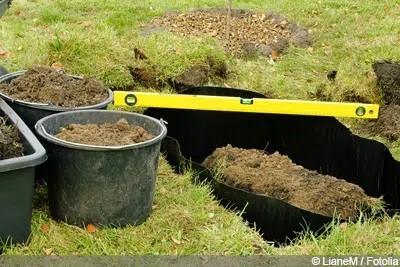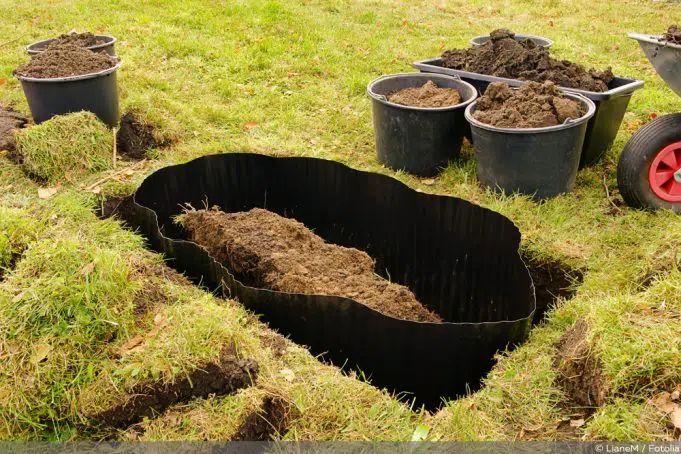Trees, shrubs and hedges develop enormous root networks under the ground. If you don’t consider this, and don’t install a root barrier, you can have a rude awakening in a few years. Often the problem becomes apparent after planting, when the runners puncture pond liners, lift stone slabs, or invade drainage systems and other crops. It can be especially problematic if the runners pop up in a neighbor’s garden.
Contents
- 1 Material
- 2 Root barrier for different bamboo species
- 3 Things to consider when installing
- 4 Installing rhizome barrier for Chinese reed
- 5 Install root barrier for sea buckthorn
- 6 Necessity of a root barrier
- 7 Risks when installing a root barrier
- 8 Alternatives to a commercial rhizome barrier
- 9 Conclusion
- 10 Author
Material
To prevent this, the trade offers special films in different thicknesses and widths. The thickness of the required rhizome barrier depends on the growth behavior of the respective plants.
The term root barrier is usually associated with bamboo. However, other plants such as reeds, raspberries or buckthorn also require a corresponding barrier. A rhizome barrier can also be installed later, but this is usually relatively difficult and, above all, very costly and labor-intensive.
Root barrier for different bamboo species

Especially with bamboo, or with most species, the installation of a rhizome barrier is essential. As a rule, it makes most sense to install it at the time of planting. Whether it is advisable to install a root barrier at a later stage can be seen from the growth habit of the bamboo species in question.
On the one hand, there is the thickness of the culms. If the diameter of the culms exceeds 3 cm or if the culms grow further than 30 cm from the actual mother plant, it is definitely advisable to install a root barrier at a later stage.
Also, if the bamboo grows taller than 4 m or its leaves are wider than 5 cm, a rhizome barrier is needed. For the species ‘Fargesia’ and ‘Borinda’, such a barrier is usually not necessary. It is most advisable to seek advice on the need for a root barrier before purchasing bamboo plants.
Things to consider when installing
A root barrier specifically for bamboo must be of a certain thickness to prevent root runners from penetrating it. A conventional pond liner, for example, is not suitable, especially for bamboo. Here, the barrier should have a thickness or thickness of at least 2 mm and a width or depth of 70 cm. Depending on the type of bamboo, a depth of 100 cm may also be advisable.
For installation, a correspondingly large area must first be staked out. The space required depends on the type of bamboo, but should not be less than 8 – 12 m². Now the staked area is excavated to a depth of 65 cm or dredged, depending on what equipment you have available.
After excavation, the root barrier is placed in the hole circumferentially and with a slight outward slope so that about 3-5 cm of the film protrude from the hole. This protrusion is important because otherwise the roots will grow over the film and can spread unhindered despite the barrier. Roots that then still protrude over the foil can be cut off without any problems. Furthermore, it is important to make sure that no stones that could damage the barrier get between the root barrier and the soil.
The ends of the film should not overlap, if possible. They are connected or screwed together with a closure rail made of aluminum. Instead of a sealing rail, the ends of the foil can also be welded, for example with a hot air gun or a foil welding device. It is essential to ensure that the ends of the foil are connected without gaps, as the strong roots of the bamboo will squeeze through even the smallest gap. Once the root barrier is in place and welded, the soil can be backfilled and the bamboo planted. Finally, the bamboo should be watered thoroughly.

Installing rhizome barrier for Chinese reed
Opinions differ on the need for a root barrier for Chinese reed. Although this plant does not form runners, the roots can still spread quite a bit. If the Chinese reed is to be placed near a pond or a well-kept lawn, installing an appropriate root barrier is definitely a good idea. Especially since this plant can also cause damage, for example, to underground pipes or sewage system.
With Chinese reed barrier does not need to be as wide as, for example, bamboo. A width or depth of 50 cm is sufficient for this plant. First you need to dig a trench around the planting hole with a diameter of 2-3 m, about 45 cm deep. The barrier is then placed in it. Here, too, you should make sure that there is an overhang at the top edge of about 3-5 cm, as well as that there are no stones behind the film. Once the barrier is installed, it can be backfilled with excavated soil and the reed planted.
For Chinese reed you do not necessarily have to use a special rhizome barrier from the trade, for this an old plastic rain barrel or a so-called mortar bucket, which you insert similar to the film in the ground and plant the reed in there, would be just as suitable. However, with both of them you would have to remove the soil beforehand. After planting, Chinese reed in both a commercial rhizome barrier and a barrel or tub, should be watered regularly.
- Installation of a rhizome barrier for raspberry plants.
- It is also advisable to install a rhizome barrier for raspberry.
- The roots of this plant spread within a radius of about 2 meters.
- In the process, they can displace other plants relatively quickly.
- If you equip raspberry bushes with a root barrier, they will then need to be watered more often.
- The roots of raspberry are much softer than those of bamboo, for example.
- Accordingly, for the root barrier can be used, among other things, strong pond liner or special barrier films.
- These are then inserted after the excavation of the earth at least 30-40 cm deep, with an overhang of 3-5 cm.
- Then you can fill the soil and plant the raspberry.
- Finally, water thoroughly here as well.

Install root barrier for sea buckthorn

Sea buckthorn are trees up to 6 m high or shrubs about 4 m high. The strong roots of sea buckthorn grow widely branched, so the appropriate root barrier is also recommended for this plant. With sea buckthorn, too, dig a trench around the planting site.
This should have a diameter of at least 1.50 m and be at least 60 cm deep. Then the respective barrier is inserted accordingly, the ends are closed professionally and the trench is filled with soil. For buckthorn, the root barrier should also protrude a few centimeters from the ground.
Necessity of a root barrier
A root barrier is especially recommended for plants that form runners. It is intended to confine these runners within a certain area, thus ensuring controlled root growth. If such plants are not blocked, their runners can cause considerable damage, e.g. to paved areas, terraces, pond liners, underground lines and cable systems, the sewer system and even buildings or their foundations.
If the root barrier is installed at the time of planting, this can be done relatively easily. Subsequent installation is much more difficult and costly. The perfect rhizome barrier must be able to withstand high pressure, especially with bamboo. In addition, it should be as smooth as possible on one side to offer the roots as little attack surface as possible.
Appropriate film for a rhizome barrier is available by the meter. To determine how many meters are needed for a single plant, for example, first measure the diameter of the planting hole and multiply the whole by three.
Retrofitting a rhizome barrier
Subsequent installation of a rhizome barrier is possible, but it requires much more effort. First, you need to dig a trench between 40 and 70 cm deep at a distance of between one and two meters from the plants. The distance to the plant depends on the respective plant species, whereby with bamboo the largest distance should be kept.
Before using the root barrier, you should dig out, if possible, all the root runners that have already grown into the plot or garden, just cutting them off is not enough. Since it is usually almost impossible to locate all the runners, it can of course happen that the next year, despite the root barrier, new shoots appear elsewhere.
The rhizome barrier is then inserted into the trench and aligned. Again, make sure that it protrudes 3-5 cm from the trench. After that, the ends are either screwed or welded by means of a closure rail. Now the trench can be backfilled with soil.
Risks when installing a root barrier
The biggest risk is improper installation of the root barrier, with the closure point between the two ends probably being the biggest weak point, especially if you have overlapped the two ends. With bamboo in particular, this can cause roots to break through the root barrier and then spread unhindered despite the barrier.
The same problem occurs if the material used for the barrier is not strong enough or stable enough to withstand the pressure of the roots, or if the barrier has been placed too close to the root area, thus constricting the roots.
Alternatives to a commercial rhizome barrier
Most commercial rhizome barriers are made of high-pressure polyethylene. For bamboo, these are probably also the safest. For other plants such as raspberries or reeds, there are also so-called root fleeces or spun fleeces. These are relatively stable and hardly penetrable by normal roots. However, the connection point, which is usually only glued, is also a weak point here.
Very stable are usually also special roof foils, with which one normally seals flat roofs, for bamboo however completely unsuitable, for other plants again an interesting alternative. Relatively well also works the already mentioned mortar bucket or plastic (PP) rain barrel, which are available in any hardware store.
Conclusion
Most plants do not need a root barrier but for a few, such as the bamboo, raspberry, reed or sea buckthorn, it is definitely recommended, even retroactively if necessary. Because if the root runners have already spread meters wide, it is very difficult to get rid of them again. It is particularly important to install the root barrier properly and to use a suitably stable material in order to exclude any possible risks from the outset.


